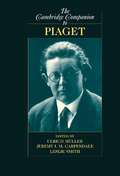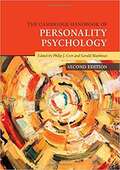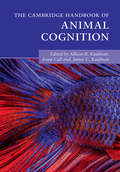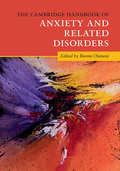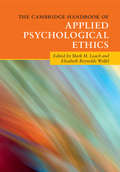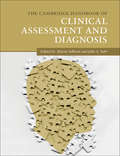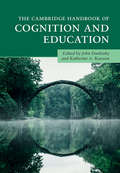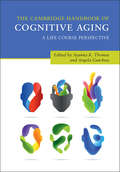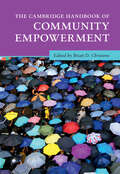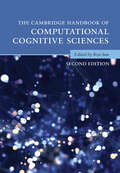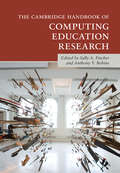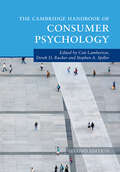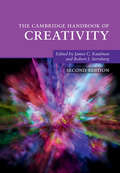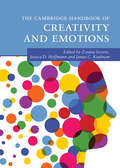- Table View
- List View
The Cambridge Companion to Keynes
by Roger E. Backhouse Bradley W. BatemanJohn Maynard Keynes (1883-1946) was the most important economist of the twentieth century. He was also a philosopher who wrote on ethics and the theory of probability and was a central figure in the Bloomsbury Group of writers and artists. In this volume contributors from a wide range of disciplines offer new interpretations of Keynes's thought, explain the links between Keynes's philosophy and his economics, and place his work and Keynesianism - the economic theory, the principles of economic policy, and the political philosophy - in their historical context. Chapter topics include Keynes's philosophical engagement with G. E. Moore and Franz Brentano, his correspondence, the role of his General Theory in the creation of modern macroeconomics, and the many meanings of Keynesianism. New readers will find this the most convenient, accessible guide to Keynes currently available. Advanced students and specialists will find a conspectus of recent developments in the interpretation of Keynes.
The Cambridge Companion to Piaget
by Ulrich Müller Jeremy I. M. Carpendale Leslie SmithJean Piaget (1896-1980) was listed among the 100 most important persons in the twentieth century by Time magazine, and his work - with its distinctive account of human development - has had a tremendous influence on a range of disciplines from philosophy to education, and notably in developmental psychology. The Cambridge Companion to Piaget provides a comprehensive introduction to different aspects of Piaget's work in a manner that does not eschew engagement with the complexities of subjects or debates yet is accessible to upper-level undergraduate students. Each chapter is a specially commissioned essay written by an expert on the subject matter. Thus, the book will also be of interest to academic psychologists, educational psychologists, and philosophers.
The Cambridge Companion to Vygotsky
by Michael Cole Harry Daniels James V. WertschL. S. Vygotsky was an early-twentieth-century Russian social theorist whose writing exerts a significant influence on the development of social theory in the early-twenty-first century. His non-deterministic, non-reductionist account of the formation of mind provides current theoretical developments with a broadly drawn yet very powerful sketch of the ways in which humans shape and are shaped by social, cultural, and historical conditions. This dialectical conception of development insists on the importance of genetic or developmental analysis at several levels. The Cambridge Companion to Vygotsky is a comprehensive 2007 text that provides students, academics, and practitioners with a critical perspective on Vygotsky and his work.
The Cambridge Encyclopedia of Child Development
by Sally Linkenauger Brian Hopkins Elena GeanguThe Cambridge Encyclopedia of Child Development remains the most authoritative and accessible account of all aspects of child development. Written by an international team of experts, its comprehensive coverage includes everything from prenatal development to adolescence, pediatrics, theories and research methods, physical development, social and emotional development, perceptual and cognitive development, language development, psychopathology, and parenting. The second edition has also been thoroughly updated to reflect major developments over the last decade in areas such as neuroscientific methods, developmental cognitive and social neuroscience, the effects of environmental influences on gene expression, and the relationship between human development and evolution. Throughout 124 entries, the Encyclopedia advocates an integrated, interdisciplinary approach to the study of child development. With clear, jargon-free style and user-friendly format, this is the essential reference for researchers and students of child development, as well as healthcare professionals, social workers, educators, and anyone interested in the well-being of children.
The Cambridge Guide to Pedagogy and Practice in Second Language Teaching
by Jack C. Richards Anne BurnsThis collection of original articles provides a state-of-the-art overview of key issues and approaches in contemporary language teaching. <p><p>Written by internationally prominent researchers, educators, and emerging scholars, the chapters are grouped into five sections: rethinking our understanding of teaching, learner diversity and classroom learning, pedagogical approaches and practices, components of the curriculum, and media and materials. <p><p>Each chapter covers key topics in teaching methodology such as reflective pedagogy, teaching large classes, outcomes-based language learning, speaking instruction, and technology in the classroom. Chapters assume no particular background knowledge and are written in an accessible style.
The Cambridge Handbook Of Personality Psychology (Cambridge Handbooks In Psychology)
by Gerald Matthews Philip J. CorrResearch on personality psychology is making important contributions to psychological science and applied psychology. This second edition of The Cambridge Handbook of Personality Psychology offers a one-stop resource for scientific personality psychology. It summarizes cutting-edge personality research in all its forms, including genetics, psychometrics, social-cognitive psychology, and real-world expressions, with informative and lively chapters that also highlight some areas of controversy. The team of renowned international authors, led by two esteemed editors, ensures a wide range of theoretical perspectives. Each research area is discussed in terms of scientific foundations, main theories and findings, and future directions for research. The handbook also features advances in technology, such as molecular genetics and functional neuroimaging, as well as contemporary statistical approaches. An invaluable aid to understanding the central role played by personality in psychology, it will appeal to students, researchers, and practitioners in psychology, behavioral neuroscience, and the social sciences.
The Cambridge Handbook of Acculturation Psychology
by John W. Berry David L. SamIn recent years the topic of acculturation has evolved from a relatively minor research area to one of the most researched subjects in the field of cross-cultural psychology. This edited handbook compiles and systemizes the current state of the art by exploring the broad international scope of acculturation. A collection of the world's leading experts in the field review the various contexts for acculturation, the central theories, the groups and individuals undergoing acculturation (immigrants, refugees, indigenous people, expatriates, students and tourists) and discuss how current knowledge can be applied to make both the process and its outcome more manageable and profitable. Building on the theoretical and methodological framework of cross-cultural psychology, the authors focus specifically on the issues that arise when people from one culture move to another culture and the reciprocal adjustments, tensions and benefits involved.
The Cambridge Handbook of Animal Cognition (Cambridge Handbooks in Psychology)
by James C. Kaufman Josep Call Allison B. KaufmanThis handbook lays out the science behind how animals think, remember, create, calculate, and remember. It provides concise overviews on major areas of study such as animal communication and language, memory and recall, social cognition, social learning and teaching, numerical and quantitative abilities, as well as innovation and problem solving. The chapters also explore more nuanced topics in greater detail, showing how the research was conducted and how it can be used for further study. The authors range from academics working in renowned university departments to those from research institutions and practitioners in zoos. The volume encompasses a wide variety of species, ensuring the breadth of the field is explored.
The Cambridge Handbook of Anxiety and Related Disorders (Cambridge Handbooks in Psychology)
by Bunmi OlatunjiThis Handbook surveys existing descriptive and experimental approaches to the study of anxiety and related disorders, emphasizing the provision of empirically-guided suggestions for treatment. Based upon the findings from the Diagnostic and Statistical Manual of Mental Disorders (DSM-5), the chapters collected here highlight contemporary approaches to the classification, presentation, etiology, assessment, and treatment of anxiety and related disorders. The collection also considers a biologically-informed framework for the understanding of mental disorders proposed by the National Institute of Mental Health's Research Domain Criteria (RDoC). The RDoC has begun to create a new kind of taxonomy for mental disorders by bringing the power of modern research approaches in genetics, neuroscience, and behavioral science to the problem of mental illness. The framework is a key focus for this book as an authoritative reference for researchers and clinicians.
The Cambridge Handbook of Applied Perception Research
by Raja Parasuraman Robert R. Hoffman Robert R. Hoffman Peter A. Hancock Mark W. Scerbo Raja Parasuraman James L. Szalma Peter A. Hancock Mark W. ScerboThe Cambridge Handbook of Applied Perception Research covers core areas of research in perception with an emphasis on its application to real-world environments. Topics include multisensory processing of information, time perception, sustained attention, and signal detection, as well as pedagogical issues surrounding the training of applied perception researchers. In addition to familiar topics, such as perceptual learning, the Handbook focuses on emerging areas of importance, such as human-robot coordination, haptic interfaces, and issues facing societies in the twenty-first century (such as terrorism and threat detection, medical errors, the broader implications of automation). Organized into sections representing major areas of theoretical and practical importance for the application of perception psychology to human performance and the design and operation of human-technology interdependence, it also addresses the challenges to basic research, including the problem of quantifying information, defining cognitive resources, and theoretical advances in the nature of attention and perceptual processes.
The Cambridge Handbook of Applied Psychological Ethics (Cambridge Handbooks in Psychology)
by Mark M. Leach Elizabeth Reynolds WelfelThe Cambridge Handbook of Applied Psychological Ethics is a valuable resource for psychologists and graduate students hoping to further develop their ethical decision making beyond more introductory ethics texts.<P><P> The book offers real-world ethical vignettes and considerations. Chapters cover a wide range of practice settings, populations, and topics, and are written by scholars in these settings. Chapters focus on the application of ethics to the ethical dilemmas in which mental health and other psychology professionals sometimes find themselves. Each chapter introduces a setting and gives readers a brief understanding of some of the potential ethical issues at hand, before delving deeper into the multiple ethical issues that must be addressed and the ethical principles and standards involved. No other book on the market captures the breadth of ethical issues found in daily practice and focuses entirely on applied ethics in psychology.<P> The first handbook to focus entirely on applied ethics in psychology.<P>Includes real-world, complex ethics cases across a variety of practice settings, populations, and topics.<P>Builds on an introductory knowledge of ethics.
The Cambridge Handbook of Applied School Psychology (Cambridge Handbooks in Psychology)
by Tammy L. Hughes Frank C. Worrell Dante D. DixsonPractice books are often simple 'how to' lists or straightforward 'recipes' and the practitioner still does not know why the activity is related to the outcome they seek. In essence, they lose how the specifics of the practice are related to the theory of change or the theory of how the problem developed in the first place. This leads to practitioners potentially removing crucial elements of best practice procedures when making modifications to tackle new or different problems in an unfamiliar context. By understanding the theoretical underpinnings, practitioners can better plan for adjustments because they know how the outcomes they seek are informed by the theory. Engagingly written and perfect for day-to-day use, this book translates state-of-the-art research and interdisciplinary theory into practical recommendations for those working with children and adolescents.
The Cambridge Handbook of Biolinguistics
by Cedric Boeckx Kleanthes K. GrohmannBiolinguistics involves the study of language from a broad perspective that embraces natural sciences, helping us better to understand the fundamentals of the faculty of language. This Handbook offers the most comprehensive state-of-the-field survey of the subject available. A team of prominent scholars working in a variety of disciplines is brought together to examine language development, language evolution and neuroscience, as well as providing overviews of the conceptual landscape of the field. The Handbook includes work at the forefront of contemporary research devoted to the evidence for a language instinct, the critical period hypothesis, grammatical maturation, bilingualism, the relation between mind and brain and the role of natural selection in language evolution. It will be welcomed by graduate students and researchers in a wide range of disciplines, including linguistics, evolutionary biology and cognitive science.
The Cambridge Handbook of Clinical Assessment and Diagnosis (Cambridge Handbooks in Psychology)
by Julie A. Suhr Martin SellbomThis Handbook provides a contemporary and research-informed review of the topics essential to clinical psychological assessment and diagnosis. It outlines assessment issues that cross all methods, settings, and disorders, including (but not limited to) psychometric issues, diversity factors, ethical dilemmas, validity of patient presentation, psychological assessment in treatment, and report writing. These themes run throughout the volume as leading researchers summarize the empirical findings and technological advances in their area. With each chapter written by major experts in their respective fields, the text gives interpretive and practical guidance for using psychological measures for assessment and diagnosis.
The Cambridge Handbook of Cognition and Education (Cambridge Handbooks in Psychology)
by John Dunlosky Katherine A. RawsonThis Handbook reviews a wealth of research in cognitive and educational psychology that investigates how to enhance learning and instruction to aid students struggling to learn and to advise teachers on how best to support student learning. The Handbook includes features that inform readers about how to improve instruction and student achievement based on scientific evidence across different domains, including science, mathematics, reading and writing. Each chapter supplies a description of the learning goal, a balanced presentation of the current evidence about the efficacy of various approaches to obtaining that learning goal, and a discussion of important future directions for research in this area. It is the ideal resource for researchers continuing their study of this field or for those only now beginning to explore how to improve student achievement.
The Cambridge Handbook of Cognitive Aging: A Life Course Perspective (Cambridge Handbooks in Psychology)
by Angela Gutchess Ayanna K. ThomasDecades of research have demonstrated that normal aging is accompanied by cognitive change. Much of this change has been conceptualized as a decline in function. However, age-related changes are not universal, and decrements in older adult performance may be moderated by experience, genetics, and environmental factors. Cognitive aging research to date has also largely emphasized biological changes in the brain, with less evaluation of the range of external contributors to behavioral manifestations of age-related decrements in performance. This handbook provides a comprehensive overview of cutting-edge cognitive aging research through the lens of a life course perspective that takes into account both behavioral and neural changes. Focusing on the fundamental principles that characterize a life course approach - genetics, early life experiences, motivation, emotion, social contexts, and lifestyle interventions - this handbook is an essential resource for researchers in cognition, aging, and gerontology.
The Cambridge Handbook of Cognitive Development (Cambridge Handbooks in Psychology)
by Olivier Houdé Grégoire BorstHow does cognition develop in infants, children and adolescents? This handbook presents a cutting-edge overview of the field of cognitive development, spanning basic methodology, key domain-based findings and applications. Part One covers the neurobiological constraints and laws of brain development, while Part Two covers the fundamentals of cognitive development from birth to adulthood: object, number, categorization, reasoning, decision-making and socioemotional cognition. The final Part Three covers educational and school-learning domains, including numeracy, literacy, scientific reasoning skills, working memory and executive skills, metacognition, curiosity-driven active learning and more. Featuring chapters written by the world's leading scholars in experimental and developmental psychology, as well as in basic neurobiology, cognitive neuroscience, computational modelling and developmental robotics, this collection is the most comprehensive reference work to date on cognitive development of the twenty-first century. It will be a vital resource for scholars and graduate students in developmental psychology, neuroeducation and the cognitive sciences.
The Cambridge Handbook of Community Empowerment (Cambridge Handbooks in Psychology)
by Brian D. ChristensPower and empowerment are critical topics for social change. This handbook maps out ways that people can collectively engage with, influence, and change systems that affect their lives, particularly the systems that maintain inequality and oppression. It includes in-depth examinations of a variety of approaches to building and exercising community power in local organizations, institutions, and settings. Each chapter examines a particular approach, critically engaging with contemporary research on how and when collective action can be most effective at producing change within communities and societal systems. By examining a range of approaches in diverse contexts, this book provides new insights for scholars, practitioners, and engaged resident-leaders aiming to be more precise, strategic, and innovative in their efforts to build and sustain community power. It is the ideal resource for those working with community groups to build more just and equitable systems.
The Cambridge Handbook of Community Psychology: Interdisciplinary and Contextual Perspectives (Cambridge Handbooks in Psychology)
by Clauss-Ehlers, Caroline S.This comprehensive handbook provides community psychology approaches to addressing the key issues that impact individuals and their communities worldwide. Featuring international, interdisciplinary perspectives from leading experts, the handbook tackles critical contemporary challenges. These include climate change, immigration, educational access, healthcare, social media, wellness, community empowerment, discrimination, mental health, and many more. The chapters offer case study examples to present practical applications and to review relevant implications within diverse contexts. Throughout, the handbook considers how community psychology plays out around the world: What approaches are being used in different countries? How does political context influence the development and extension of community psychology? And what can nations learn from each other as they examine successful community psychology-based interventions? This is essential reading for researchers, students, practitioners, and policy makers involved with community well-being.
The Cambridge Handbook of Computational Cognitive Sciences (Cambridge Handbooks in Psychology)
by Ron SunThe Cambridge Handbook of Computational Cognitive Sciences is a comprehensive reference for this rapidly developing and highly interdisciplinary field. Written with both newcomers and experts in mind, it provides an accessible introduction of paradigms, methodologies, approaches, and models, with ample detail and illustrated by examples. It should appeal to researchers and students working within the computational cognitive sciences, as well as those working in adjacent fields including philosophy, psychology, linguistics, anthropology, education, neuroscience, artificial intelligence, computer science, and more.
The Cambridge Handbook of Computing Education Research (Cambridge Handbooks in Psychology)
by Sally A. Fincher Anthony V. RobinsThis Handbook describes the extent and shape of computing education research today. Over fifty leading researchers from academia and industry (including Google and Microsoft) have contributed chapters that together define and expand the evidence base. The foundational chapters set the field in context, articulate expertise from key disciplines, and form a practical guide for new researchers. They address what can be learned empirically, methodologically and theoretically from each area. The topic chapters explore issues that are of current interest, why they matter, and what is already known. They include discussion of motivational context, implications for practice, and open questions which might suggest future research. The authors provide an authoritative introduction to the field and is essential reading for policy makers, as well as both new and established researchers.
The Cambridge Handbook of Consumer Psychology (Cambridge Handbooks in Psychology)
by Derek D. Rucker Cait Lamberton Stephen A. SpillerIn the last two years, consumers have experienced massive changes in consumption – whether due to shifts in habits; the changing information landscape; challenges to their identity, or new economic experiences of scarcity or abundance. What can we expect from these experiences? How are the world's leading thinkers applying both foundational knowledge and novel insights as we seek to understand consumer psychology in a constantly changing landscape? And how can informed readers both contribute to and evaluate our knowledge? This handbook offers a critical overview of both fundamental topics in consumer psychology and those that are of prominence in the contemporary marketplace, beginning with an examination of individual psychology and broadening to topics related to wider cultural and marketplace systems. The Cambridge Handbook of Consumer Psychology, 2nd edition, will act as a valuable guide for teachers and graduate and undergraduate students in psychology, marketing, management, economics, sociology, and anthropology.
The Cambridge Handbook of Creativity
by Robert J. Sternberg James C. Kaufman"The Cambridge Handbook of Creativity is a comprehensive scholarly handbook on creativity from the most respected psychologists, researchers, and educators. This handbook serves both as a thorough introduction to the field of creativity and as an invaluable reference and current source of important information. It covers such diverse topics as the brain, education, business, and world cultures. The first section, "Basic Concepts," is designed to introduce readers to both the history of and key concepts in the field of creativity. The next section, "Diverse Perspectives of Creativity," contains chapters on the many ways of approaching creativity. Several of these approaches, such as the functional, evolutionary, and neuroscientific approaches, have been invented or greatly reconceptualized in the last decade. The third section, "Contemporary Debates," highlights ongoing topics that still inspire discussion. Finally, the editors summarize and discuss important concepts from the book and look to what lies ahead"--Provided by publisher.
The Cambridge Handbook of Creativity (Cambridge Handbooks in Psychology)
by Robert J. Sternberg James C. KaufmanThis second edition of the renowned Cambridge Handbook of Creativity expands on the first edition with over two thirds new material reaching across psychology, business, entrepreneurship, education, and neuroscience. It introduces creativity scholarship by summarising its history, major theories and assessments, how creativity develops across the lifespan, and suggestions for improving creativity. It also illustrates cutting-edge work on genetics and the neuroscience of creativity, alongside creativity's potential for both benevolence and malevolence. The chapters cover the related areas of imagination, genius, play, and aesthetics and tackle questions about how cultural differences, one's physical environment, mood, and self-belief can impact creativity. The book then examines the impacts on creativity of behaviour by teachers, managers, and leaders in particular.
The Cambridge Handbook of Creativity and Emotions (Cambridge Handbooks in Psychology)
by James C. Kaufman Zorana Ivcevic Jessica D. HoffmannThe Cambridge Handbook of Creativity and Emotions provides a state-of-the-art review of research on the role of emotions in creativity. This volume presents the insights and perspectives of sixty creativity scholars from thirteen countries who span multiple disciplines, including developmental, social, and personality psychology; industrial and organizational psychology; neuroscience; education; art therapy, and sociology. It discusses affective processes – emotion states, traits, and emotion abilities – in relation to the creative process, person, and product, as well as two major contexts for expression of creativity: school, and work. It is a go-to source for scholars who need to enhance their understanding of a specific topic relating to creativity and emotion, and it provides students and researchers with a comprehensive introduction to creativity and emotion broadly.

